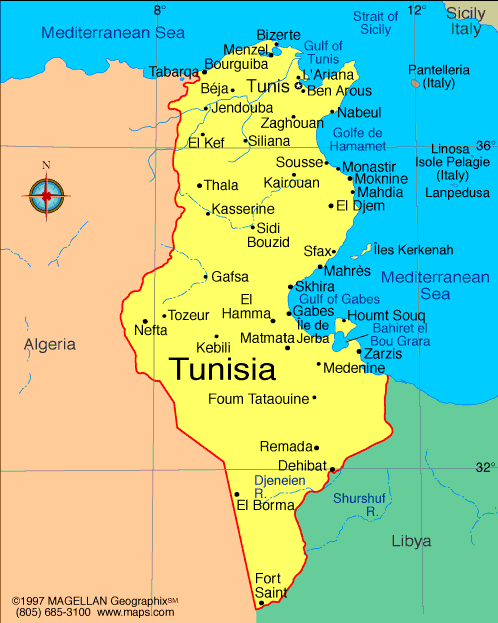TUNISIA

Geography: Tunisia, at the northernmost bulge of Africa, thrusts out toward Sicily to mark the division between the eastern and western Mediterranean Sea. Twice the size of South Carolina, it is bordered on the west by Algeria and by Libya on the south. Coastal plains on the east rise to a north-south escarpment that slopes gently to the west. The Sahara Desert lies in the southernmost part. Tunisia is more mountainous in the north, where the Atlas range continues from Algeria.
Government: Republic.
History: Tunisia was settled by the Phoenicians in the 12th century B.C. By the sixth and fifth centuries B.C. , the great city-state of Carthage (derived from the Phoenician name for “new city”) dominated much of the western Mediterranean. The three Punic Wars between Rome and Carthage (the second was the most famous, pitting the Roman general Scipio Africanus against Carthage's Hannibal) led to the complete destruction of Carthage by 146 B.C.
Except for an interval of Vandal conquest in A.D. 439–533, Carthage was part of the Roman Empire until the Arab conquest of 648–669. It was then ruled by various Arab and Berber dynasties, followed by the Turks, who took it in 1570–1574 and made it part of the Ottoman Empire until the 19th century. In the late 16th century, it was a stronghold for the Barbary pirates. French troops occupied the country in 1881, and the bey, the local Tunisian ruler, signed a treaty acknowledging it as a French protectorate.
Nationalist agitation forced France to recognize Tunisian independence and sovereignty in 1956. The constituent assembly deposed the bey on July 25, 1957, declared Tunisia a republic, and elected Habib Bourguiba as president. Bourguiba maintained a pro-Western foreign policy that earned him enemies. Tunisia refused to break relations with the U.S. during the Arab-Israeli War in June 1967. Concerned with Islamic fundamentalist plots against the state, the government stepped up efforts to eradicate the movement, including censorship and frequent detention of suspects.
In 1987, the aged Bourguiba was declared mentally unfit to continue as president and was removed from office in a bloodless coup. He was succeeded by Gen. Zine al-Abidine Ben Ali, whose tenure has been marked by repression, a poor human rights record, the rise in Islamic fundamentalism, and growing anti-Western sentiments among the populace. Ben Ali was reelected in Oct. 1999 with 99% of the vote in an election criticized by many human rights observers. In May 2000 Ben Ali's Constitutional Democratic Assembly Party swept local elections with 92% of the vote, in a contest many opposition leaders boycotted. However, Tunisia's economy continued to improve in the late 1990s, making the country one of the most attractive in Africa for foreign investors. In May 2002, a referendum passed that ended the three-term limit for the presidency. It permitted Ben Ali, who has served as president for more than 15 years, to run for two more terms. Opposition parties protested. In Oct. 2004, the president was reelected with 94% of the vote. Ali won a fifth term in Oct. 2009, taking 89.6% of the vote.

Map of Tunisia
President: Beji Caid Essebsi (2014)
Prime Minister: Habib Essid (2014)
Land area: 59,985 sq mi (155,361 sq km);
total area: 63,170 sq mi (163,610 sq km)
Population (2014 est.): 10,937,521 (growth
rate: 0.92%); birth rate: 16.9/1000; infant mortality rate: 23.19/1000;
life expectancy: 75.68; density per sq mi: 163
Capital and largest city (2013 est.):
Tunis, 2,321,227 (metro. area), 651,183 (city
proper)
Monetary unit: Tunisian
dinar
Tunisian Republic
National
name: Al-Jumhuriyah at-Tunisiyah
Languages:
Arabic (official, commerce), French
(commerce), Berber (Tamazight)
Ethnicity/race:
Arab-Berber 98%, European 1%, Jewish and other
1%
Religions:
Islam (Sunni) 99.1%, other (includes Christian, Jewish, Shia Muslim, and Baha'i) 1%
Literacy rate: 79.1% (2010
est.)
Economic summary: GDP/PPP
(2013 est.): $108.4 billion; per capita $9,900. Real growth rate:
2.8%. Inflation: 6.1%. Unemployment: 17.2%. Arable
land: 17.35%. Agriculture: olives, olive oil, grain, tomatoes,
citrus fruit, sugar beets, dates, almonds; beef, dairy products.
Labor force: 3.974 million (2013 est.);
services 49.8%, industry 31.9%, agriculture 18.3% (2009 est.).
Industries: petroleum, mining (particularly phosphate and iron
ore), tourism, textiles, footwear, agribusiness, beverages. Natural
resources: petroleum, phosphates, iron ore, lead, zinc, salt.
Exports: $17.46 billion (2013 est.): clothing,
semi-finished goods and textiles, agricultural products, mechanical
goods, phosphates and chemicals, hydrocarbons, electrical equipment.
Imports: $24.95 billion (2013 est.): textiles, machinery
and equipment, hydrocarbons, chemicals, foodstuffs. Major trading
partners: France, Italy, Germany, Spain, Libya, China, Algeria, U.S. (2012).
Communications: Telephones: main lines in
use: 1.105 million (2012); mobile cellular: 12.84 million (2012). Radio
broadcast stations: broadcast media is mainly
government-controlled; the state-run Tunisian Radio and Television
Establishment (ERTT) operates 2 national TV networks, several national
radio networks, and a number of regional radio stations; 1 TV and 3
radio stations are privately-owned and report domestic news stories
directly from the official Tunisian news agency; the state retains
control of broadcast facilities and transmitters through L'Office
National de la Telediffusion; Tunisians also have access to Egyptian,
pan-Arab, and European satellite TV channels (2007). Radios:
2.06 million (1997). Television broadcast stations: 26
(plus 76 repeaters) (1995). Televisions: 920,000 (1997).
Internet Service Providers (ISPs): 576 (2012). Internet
users: 3.5 million (2009).
Transportation:
Railways: total: 2,165 km (2011). Highways: total: 19,418
km; paved: 14,756 km; unpaved: 4,662 km (2010). Ports and
harbors: Bizerte, Gabes, Rades, Sfax, Sousse.
Airports: 29 (2013).
International
disputes: none.
-------------------- o --------------------
No comments:
Post a Comment